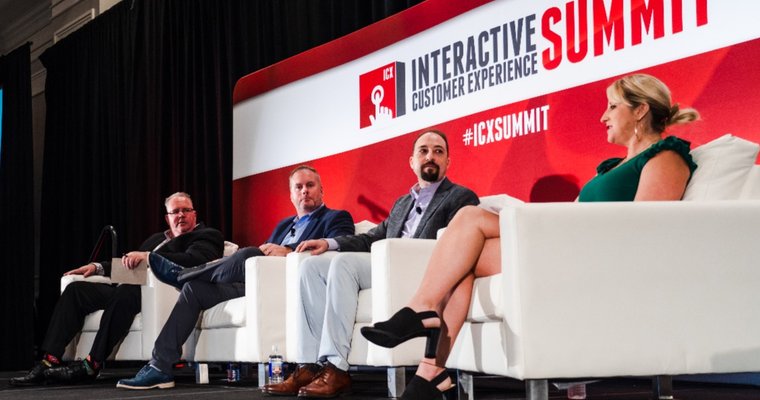Brands often grapple with a difficult decision — whether to build their own interactive system or hit the market and buy one. It was the topic of discussion at the June 3 general session “Build It Or Buy It? What You Should Consider First” at the ICX Association Summit in Columbus, Ohio.
For most companies, it’s a wise idea to implement interactive technology to engage and please customers.
Brands, however, often grapple with a difficult decision — whether to build their own interactive system or hit the market and buy one. It was the topic of discussion at the June 3 general session «Build It Or Buy It? What You Should Consider First» at the ICX Association Summit in Columbus, Ohio. Base22, a digital firm that helps companies connect customer and employee experiences across platforms to harness data and innovative technology, sponsored the session.
Cherryh Cansler, VP of events and editor of Fast Casual.com, Networld Media Group, moderated the session. Panelists included J Ackley, VP, Spark Technologies Development, Dickey’s Barbecue Restaurants, Inc., Kevin Armstrong, chief innovation officer, Base22 and Ben Hall, chief information officer, Krispy Kreme.
Hall said Krispy Kreme has many tech stacks, all trying to work together to make the donut brand successful.
«Within the space of e-commerce, it’s primarily a custom-built architecture, so it sits on AWS,» Hall said. «On the POS side, we’re currently with NCR Aloha. One of the challenges, as Krispy Kreme has grown, we’ve bought back a number of territories around the world and they all have their own systems. So, that’s a discussion for us — where do we go next in terms of U.S. based software and how that will play out.»
At Dickey’s, Ackley said the barbeque fast casual chain developed its own POS and an entire tech stack built in-house. In the back of the house, Dickey’s created its Smokestack software that communicates with the brand’s franchisees through dashboard reporting.
«It can actually deliver out, to our franchises, dashboard and real-time statistics straight to their POS. We have a lot of information going out,» Ackley said. «It’s a very new system that helps to be able to pivot very quickly, especially in today’s times.»
Scale-ability and having flexible options were the biggest reasons Dickey’s nixed a traditional POS to build its own, Ackley said. The brand uses iPads and the iOS system to keep staff connected.
Armstrong said a major goal of Base22 is to be platform-focused. He said brands such as Dickey’s, which was founded more than 80 years ago, should not have to scrap their legacy to implement modern interactive technology. It’s wise for brands to take a «de-coupled» approach to using platforms.
«If you treat the solutions that are going after that audience, so if you’re in customers or your employee customers, if you treat them as a separate solution stack, then they can be de-coupled from the data or the workloads you’re exposing through those,» Armstrong said. «That’s oftentimes how we bring that forward. We’ll use a customer experience platform that’s very agnostic to do that. But, then you can also go further down the stack to use like iOS and Microsoft tools. It allows you to be very flexible, which is key. Everyone saw that when we had to adjust to COVID.»
Overall, Hall said the tech ecosystem carries plenty of value. Every stop along the route has to be scrutinized.
«It’s not just the POS, it’s the POS and the data loads — where does the data go to your financials and how does it integrate with all the third-party entities and e-commerce?» Hall said. «You definitely have to take a based approach.
«In the build vs. buy discussion, the debate hinges on — what is the differentiator for your business?»
Hall said Krispy Kreme wanted to have a reliable POS, but with technology changing quickly in the past five years, there were many other interactive tools to consider. Businesses should constantly be revaluating their true differentiators, Hall said.
Determining a business’s core factor of why it should or should not design its own platform must also be considered, according to Ackley. He said brands must be mindful of not «over-engineering» a system to avoid complications.
«If you’re going to buy a tech stack, you have to be very selective,» Ackley said. «And, you have to consider the labor market. How much will all of this cost your business?»
If companies decide to buy, they should find a reliable partner, Ackley said. Does the partner’s objectives align with what the brand is doing? Will it pay off in the end? Hall said it can be easy to not hold tech vendors accountable.
«You have to know when to let them go,» Armstrong said, emphasizing that businesses should have the right infrastructure in place before introducing new tech platforms such as AI and machine learning. «If they don’t mirror what you’re doing, it might not be the best partner.»
Not continuing to learn cutting edge technologies, Hall said, can be one of the most crucial mistakes brands can make. Businesses should consider using AI, but if they’re not there yet, low code is another solid option. Low code is a development platform that provides an environment to create application software through a graphical user interface.
«You need to have the tools that allow you to do things quickly,» he said. «Krispy Kreme rolled out an e-commerce platform in February 2020, right before COVID hit. Just to have something in place really made a difference.»
Armstrong said it’s vital for businesses — especially in customer service — to get some type of platform in place. Bringing in low code is a nice starting point, he said.
«Tech is here to enable businesses, but it’s also hear to help customers,» Armstrong said.

